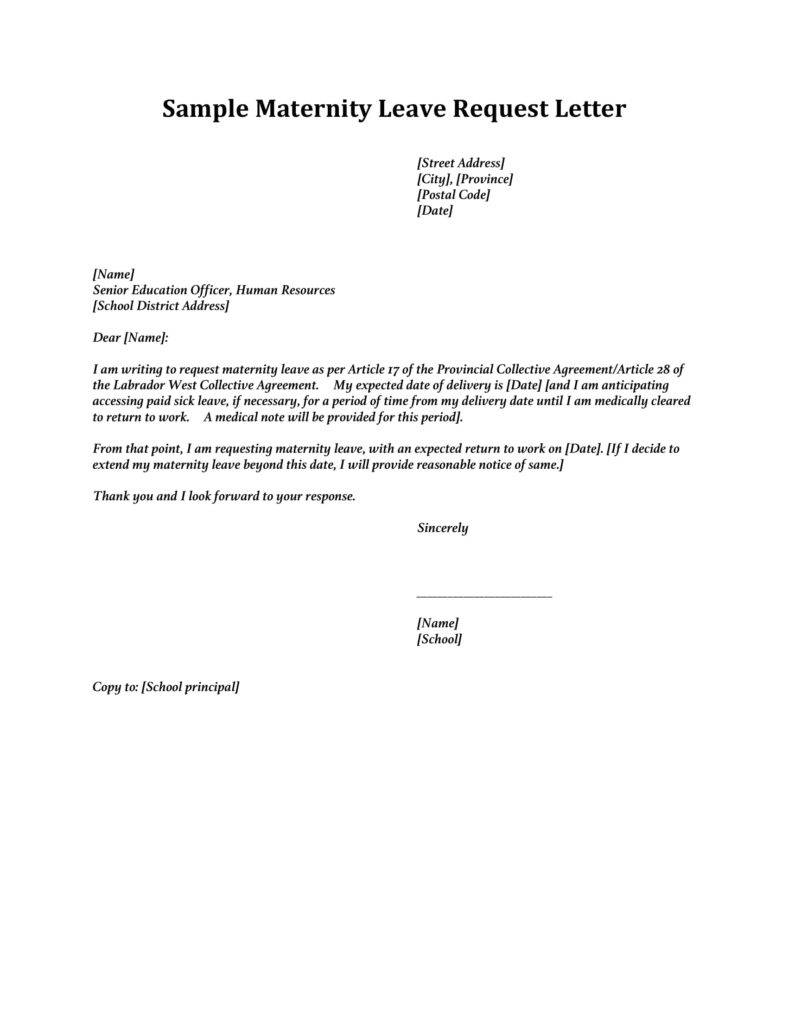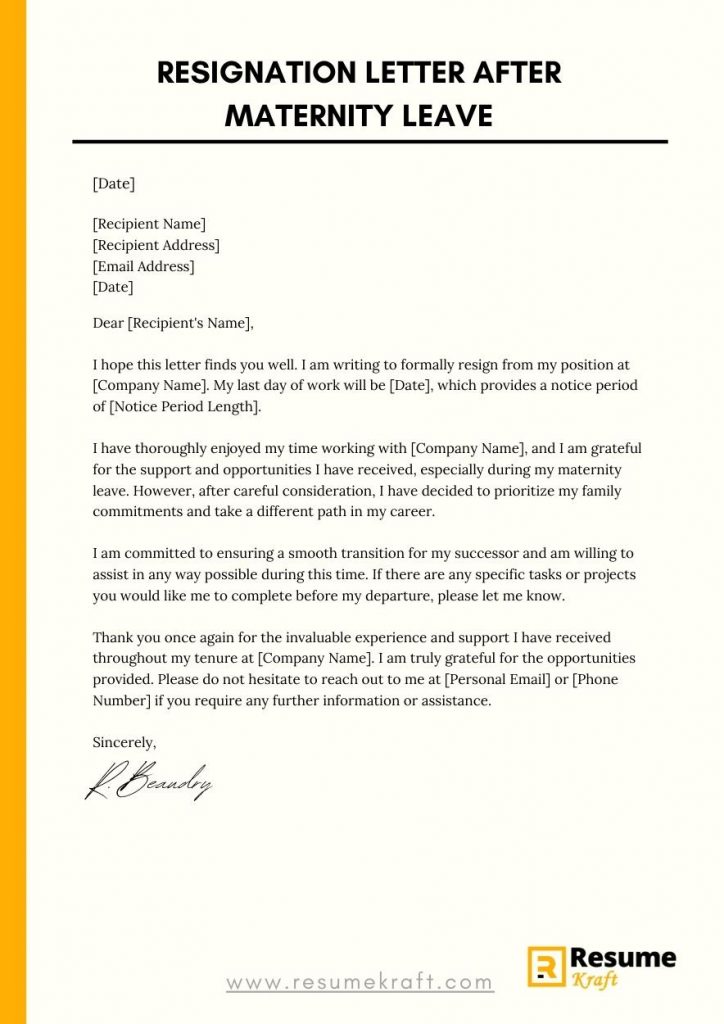The Maternity Letter Template You Need for Your Boss: Navigating a Smooth Transition
Congratulations! You’re expecting a baby, a joyous event that brings with it a whirlwind of planning and preparation. One of the most crucial steps in this process is informing your employer and initiating the process of maternity leave. While the conversation itself is important, a well-crafted maternity letter serves as a formal record of your plans, ensuring clarity and facilitating a smooth transition for both you and your company. This article provides a comprehensive guide and template to help you write the perfect maternity letter, tailored for your boss.
Why You Need a Maternity Letter
A maternity letter isn’t just a formality; it’s a vital tool for:
- Formalizing the Announcement: It provides a written record of your intention to take maternity leave.
- Outlining Your Plans: It details your expected leave dates, allowing your employer to plan accordingly.
- Protecting Your Rights: It serves as documentation of your request for leave, which is crucial if any disputes arise.
- Facilitating a Smooth Transition: It helps your employer prepare for your absence, minimizing disruption to your team and projects.
- Professionalism: It demonstrates your commitment to your role and your desire to maintain a positive working relationship.
Essential Elements of Your Maternity Letter
Your maternity letter should be clear, concise, and professional. Here’s a breakdown of the key elements:
- Your Contact Information: Your full name, address, phone number, and email address.
- Date: The date you are sending the letter.
- Recipient Information: Your boss’s name and title, company name, and company address.
- Formal Salutation: Use a professional greeting like “Dear [Boss’s Name]”.
- The Announcement: Clearly state your pregnancy and your expected due date.
- Leave Dates: Specify your anticipated start and end dates for your maternity leave. Be as precise as possible, keeping in mind that these dates may be subject to change.
- Return to Work Date (If Known): Indicate your anticipated return to work date. If you’re unsure, state “I anticipate returning to work on or around [Date].”
- Information on Transition Planning: Briefly outline any steps you’ve taken or plan to take to prepare for your leave, such as training colleagues or documenting your responsibilities.
- Offer of Assistance: Express your willingness to assist with the transition process before and after your leave.
- Closing: Use a professional closing like “Sincerely” or “Best regards.”
- Your Signature: Sign the letter above your typed name.
Sample Maternity Letter Template
Here’s a template you can adapt to your specific circumstances:
[Your Name]
[Your Address]
[Your Phone Number]
[Your Email Address]
[Date]
[Boss's Name]
[Boss's Title]
[Company Name]
[Company Address]
Dear [Boss's Name],
I am writing to inform you of my pregnancy and my intention to take maternity leave. My estimated due date is [Due Date].
I plan to begin my maternity leave on or around [Start Date] and anticipate returning to work on or around [Return to Work Date]. I understand that these dates may be subject to change.
I am committed to ensuring a smooth transition during my absence. I am happy to discuss my responsibilities, train colleagues, and create documentation to minimize disruption to my work. I am also available to assist with any questions or offer support during and after my leave.
I will keep you updated as my due date approaches and my plans solidify.
Thank you for your support and understanding.
Sincerely,
[Your Signature]
[Your Typed Name]
Customizing Your Letter: Key Considerations
- Company Policies: Familiarize yourself with your company’s maternity leave policies and incorporate relevant information into your letter. Mention any specific forms you need to complete.
- Your Role and Responsibilities: Tailor the section on transition planning to reflect your specific role and the tasks you perform.
- Communication Preferences: Indicate your preferred method of communication during your leave (e.g., email, phone) and how often you anticipate checking in.
- Legal Advice: Consult with an employment lawyer if you have specific questions or concerns about your rights.
- Delivery Method: Submit the letter according to your company’s protocol (e.g., email, physical copy).
Before You Send: A Checklist
- Proofread Carefully: Ensure your letter is free of grammatical errors and typos.
- Review Company Policy: Confirm your leave dates and any specific requirements.
- Get a Second Opinion: Ask a trusted colleague or friend to review your letter.
- Keep a Copy: Retain a copy of the letter for your records.
- Schedule a Meeting: Follow up your letter with a face-to-face meeting to discuss your plans in more detail.
Frequently Asked Questions (FAQs)
1. When should I give my boss the maternity letter?
It’s generally recommended to give your boss your maternity letter as soon as you feel comfortable, typically after you’ve informed your immediate supervisor and/or HR. Aim to provide sufficient notice (typically 2-3 months) to allow for adequate planning.
2. Can I change my leave dates after submitting the letter?
Yes, your leave dates can be adjusted. However, it is best to communicate any changes to your boss and HR as soon as possible, providing a new written update to the letter.
3. What if my company doesn’t have a formal maternity leave policy?
Even if your company doesn’t have a formal policy, it’s still crucial to submit a maternity letter. This documentation protects your rights and allows for open communication. You can research federal and state laws regarding maternity leave to ensure your rights are protected.
4. What should I include if I plan to work remotely during my leave?
If you plan to work remotely during your leave, clearly state this in your letter, outlining your anticipated availability and responsibilities. Be sure to discuss this with your employer and establish clear expectations.
5. Can I use this template for a paternity leave letter?
Yes, you can adapt this template for a paternity leave letter by adjusting the language to reflect your role as the father. Ensure to include your expected leave dates and plans for transition.
Conclusion
Writing a maternity letter is an essential step in navigating your pregnancy and planning for your leave. By following these guidelines and utilizing the provided template, you can create a professional, informative letter that facilitates a smooth transition for both you and your employer. Remember to tailor the letter to your specific circumstances, company policies, and desired level of involvement during and after your leave. Congratulations again, and best wishes for a healthy pregnancy and a happy family!




